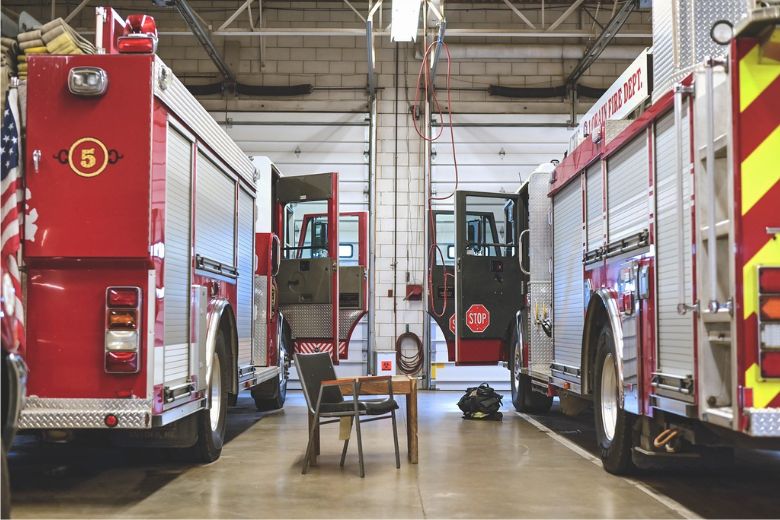Designing Efficient, Healthy, and Community-Focused Fire Stations
Fire stations serve as a critical hub for firefighting operations, functioning as both a workplace and a second home for firefighters. As such, they must maximize operational efficiency, support firefighter wellness, and foster community engagement. The design of these facilities is essential in ensuring that they provide safe and functional environments that align with the department’s goals.
In this article, we discuss the key aspects of designing fire stations that meet these needs through meticulous planning and innovative solutions.
Improving Overall Efficiency
Enhancing the overall efficiency of a fire station is crucial for improving response times and departmental ISO ratings. Effective design must include well-placed components that facilitate quick and efficient movement within the station. This means creating clear pathways and strategically positioning key areas such as apparatus bays, equipment storage, and living quarters to minimize the time it takes for firefighters to respond to emergencies.
Incorporating spaces for continuous training is also vital. Specialty rooms for classroom and safety training ensure that firefighters can continuously improve their skills and knowledge. These areas can also be used for community education classes such as CPR and first aid training, which not only benefit the community but also enhance the station’s role as a community hub.

Promoting Firefighter Wellness
The health and wellness of firefighters is a paramount concern, especially given their increased risk of cancer and other health issues. Fire station design can play a significant role in mitigating these risks. One effective approach is implementing a zone strategy for contamination control. This strategy involves isolating different areas of the station to reduce exposure to contaminants, thereby preventing the spread of toxins into living and working spaces.
Additionally, providing flexible spaces such as common areas, quiet rooms, and workout facilities — separated from apparatus bays — promotes healthy habits and reduces long-term health risks. These spaces allow firefighters to relax, decompress, and maintain physical fitness, which are all crucial for their overall well-being.
Bolstering Community Engagement
Community involvement is a core value for many fire departments, and fire station design can greatly enhance this engagement. Flexible spaces for community education classes and large gatherings foster activity and connection within the station. By including areas that can be used for public meetings, educational programs, and social events, fire stations can become integral parts of the community.
Engaging with stakeholders during the design process ensures that the fire station aligns with community goals and enhances local engagement. This collaboration helps build trust and support for the fire department, making it a vital part of the community fabric.
Trends and Challenges in Fire Station Design
Rising Construction Costs: The cost of constructing fire stations has significantly increased, from $50-60 per square foot in the 1980s to $190-250 per square foot today. This rise in costs is driven by several factors, including the transition to combination and career departments, stringent building regulations, and higher land acquisition costs. To manage these expenses, municipalities are now aligning their budget planning with fire station needs, ensuring financial efficiency and transparency.
Technological Precision for Site Selection: Utilizing Geographical Information Systems (GIS) allows fire departments to identify optimal locations for new stations. GIS data can highlight community hazards, population densities, and access to major roadways, ensuring that new stations are strategically placed to improve response times. This technology helps guide decisions on whether to build new stations or renovate existing ones.
Dedicated Training Facilities: With 70% of firefighters being volunteers in the USA for example, ongoing training is essential. Integrating training facilities into fire stations supports rigorous, real-time training, promoting collaboration among departments and aiding in the recruitment of young candidates. These facilities ensure that firefighters can maintain high standards in emergency response.
Involving Fire Departments in City Planning: Fire services are increasingly involved in city planning to ensure that new developments and infrastructure support emergency response needs. This collaboration helps maintain response times and enhances community safety by ensuring that emergency vehicles have the necessary access.

Green Fire Station Design: Sustainable design elements such as vegetative roofs, photovoltaic panels, and energy-efficient windows are becoming standard in modern fire stations. These features reduce energy costs and environmental impact, which incorporate geothermal heating and cooling, solar PV, and LED lighting.
Inclusive Designs for All Genders: Modern fire stations are designed with private sleeping quarters and bathrooms to promote inclusivity and support a diverse workforce. These gender-neutral designs create a welcoming environment for all firefighters, encouraging a more diverse and inclusive fire department.
Co-location: The trend of co-locating fire and law enforcement services is growing, particularly in smaller jurisdictions where maintaining separate departments is financially challenging. Co-location facilitates resource sharing and operational efficiency, making it a practical solution for many communities.
Performance-Forward Design: Modern fire stations are designed to enhance emergency responders’ performance, featuring single-story layouts and four-fold side-motion doors for improved response times. Training facilities within the station support various emergency response exercises, ensuring that firefighters are well-prepared for diverse situations.
Focus on Community and Education: Fire stations play a vital role in their communities, serving as meeting spaces and educational centers. Educating the public about fire services and emergency response is crucial for gaining community support and understanding the importance of fire stations. Fire stations that offer community rooms and host events help strengthen the bond between the fire department and the community it serves.
Summary
The evolution of fire station design reflects a deeper understanding of firefighter needs and community integration. By addressing rising construction costs, incorporating advanced technology, promoting inclusivity, and fostering community engagement, modern fire stations are better equipped to serve both their occupants and the public. Thoughtful design and strategic planning ensure fire stations support the health, safety, and well-being of firefighters and their communities.
Designing Efficient, Healthy, and Community-Focused Fire Stations is written by Ivy Cosca Contributing Editor at Marcus Media.


